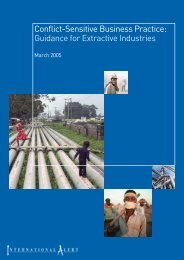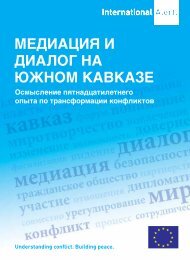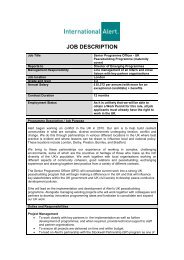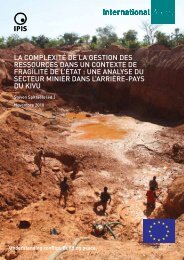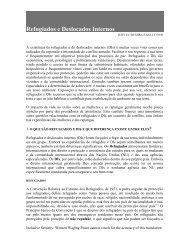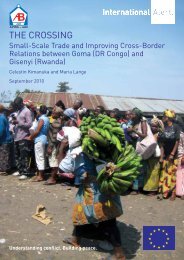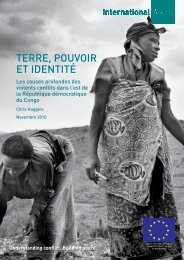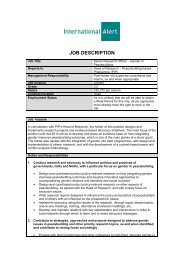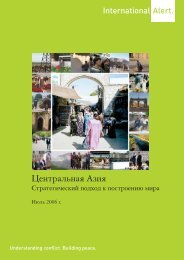What peace and Whose? - Internal Displacement Monitoring Centre
What peace and Whose? - Internal Displacement Monitoring Centre
What peace and Whose? - Internal Displacement Monitoring Centre
Create successful ePaper yourself
Turn your PDF publications into a flip-book with our unique Google optimized e-Paper software.
14 International Alertof the country struggling with violence <strong>and</strong> conflict. In Liberia the civil war which started in 1989passed through several unsuccessful agreements, notably in 1995, before a final <strong>peace</strong> agreementwas reached in 2003. Two years later a Truth <strong>and</strong> Reconciliation Commission was set up which thenundertook a four-year process, culminating in a final report of findings <strong>and</strong> recommendations. Thisreport was then shelved, illustrating that the <strong>peace</strong> process still had far to go. In Northern Irel<strong>and</strong>, thebreakthrough Good Friday Agreement was reached in 1998, some seven years after talks began. Morethan a decade later, the agreement still held, but violence had not entirely disappeared.Other <strong>peace</strong> processes <strong>and</strong> agreements also illustrate the need for patience <strong>and</strong> the reality that stepsforward are often followed by apparent steps back. In the countries of the former Yugoslavia, themaking <strong>and</strong> building of <strong>peace</strong> was done during <strong>and</strong> after the violent break-up of Yugoslavia. The mostprominent <strong>peace</strong> agreement, the 1994 Dayton Peace Accords, was only one part of this process <strong>and</strong>did not anticipate or prevent further conflict <strong>and</strong> the later secession of Kosovo from Serbia. In 2000 the<strong>peace</strong> process between Israel <strong>and</strong> the Palestinians collapsed after nine years of disputed progress,during which political agreements were not matched by realities on the ground <strong>and</strong> improvements intrust <strong>and</strong> confidence. In more than a decade since then, an effective Israeli-Palestinian <strong>peace</strong> processhas still not been created. In Somalia, the region of Somalil<strong>and</strong> unilaterally declared independencein 1991. More than two decades later, the border between Somalil<strong>and</strong> <strong>and</strong> the neighbouring region ofPuntl<strong>and</strong> is still disputed <strong>and</strong> intermittently fought over. Meanwhile, the central <strong>and</strong> southern parts ofSomalia have remained riven by civil war, despite repeated <strong>peace</strong> processes <strong>and</strong> <strong>peace</strong> agreements.Together, such examples – <strong>and</strong> the variation between them – give a brief reminder of how varied <strong>and</strong>uncertain <strong>peace</strong> <strong>and</strong> <strong>peace</strong>building can be. Moreover, they show how important it is for those who want<strong>peace</strong> to keep working for it, long after the ceasefire or the <strong>peace</strong> agreement has been implemented.Peace presentToday, <strong>peace</strong> in South Sudan <strong>and</strong> Sudan remains incomplete <strong>and</strong> will likely remain so, in thenear future. The evidence for this is the persistent occurrence <strong>and</strong> risk of violent conflict, mostlyoutside <strong>and</strong> away from the capitals, main cities <strong>and</strong> towns. The patterns, types <strong>and</strong> locationsof conflict are quite well known. The conflict can be sporadic, intense or prolonged. In Sudan,violent conflict is present or at risk of occurring particularly in Abyei, Blue Nile, Darfur <strong>and</strong> SouthKordofan. In South Sudan, violent conflict is present or at risk of occurring particularly in EasternEquatoria, Jonglei, Lakes, Unity, Upper Nile <strong>and</strong> Warrap. Within each country there is a risk ofwidening conflict, as well as escalation to direct or indirect war between the two countries, despitedesires <strong>and</strong> efforts to avoid this happening.Since the formal end of the CPA in July 2011 the pattern of conflict <strong>and</strong> violence has been much thesame as before <strong>and</strong> people’s experience of <strong>peace</strong> has changed little. In Darfur the conflict betweenrebel groups <strong>and</strong> the government has remained unresolved, despite the government’s attempt toimplement an agreement with one group. The future status of Abyei has continued to be contested bythe inhabitants of the area <strong>and</strong> by the two governments, whose armed forces have clashed in Abyeibefore. In Blue Nile <strong>and</strong> South Kordofan civilians have been killed <strong>and</strong> displaced by fighting betweenthe Sudan Armed Forces (SAF) <strong>and</strong> the Sudan People’s Liberation Army-North (SPLA-N). In SouthSudan civilians have been affected by rebellions led by renegade SPLA comm<strong>and</strong>ers, southern soldiersdemobilised from the SAF, <strong>and</strong> others. The violence has been concentrated in rural areas in Jonglei,Unity, Upper Nile <strong>and</strong> Warrap states. Overlapping with this violence has been inter-communalviolence, for example between the Lou Nuer <strong>and</strong> Murle in Jonglei.To a large extent, therefore, the challenges of the <strong>peace</strong> which exists today in each country reflectthe challenges of the <strong>peace</strong> which existed under the CPA between 2005 <strong>and</strong> 2011. The underlyingcauses of conflict are not new, as Table 3 shows.





